RBA Annual Conference – 1999 Capital Flows and Exchange Rates Stephen Grenville and David Gruen[*]
1. Introduction
In summarising the state of play on the ‘New International Financial Architecture’, The Economist[1] has noted that ‘the official architects are strangely silent about another crucial aspect of global financial reform: exchange rates’. In part, this is because something quite abnormal happened with exchange rates (perhaps before, and certainly during, the crisis) which does not fit comfortably with the theoretical models of exchange rate behaviour. Looking forward, the importance of exchange rates is acknowledged, but there is no agreement on what should be done. The discussion has been, at best, partial, focusing on the need for greater flexibility in exchange rates for emerging market countries, with some suggesting that corner solutions (either rigidly fixed – probably via a Currency Board – or pure floating) may be inevitable.[2] The latter point seems debatable,[3] and the former begs the question of just what would have happened had these countries floated earlier.
While there is room for different opinion on exchange rate regimes, the basic core ideas seem straightforward enough, at least in principle. The anchor for a real exchange rate is found in the real productive sector of an economy – an exchange rate reflects a country's international competitiveness. This may need to change over time. So, as a starting point, there may be a presumption that exchange rates should have the capacity to adjust – to some degree – over time, in response to shocks or (gradually) in response to the changing productive capacity of an economy.
This view – that a country's real exchange rate or international competitiveness finds its basic fundamentals in its capacity to produce tradeable goods – puts the focus on the goods and services components of the external account. Even where there are external capital flows or cyclical changes in policy settings, these cause temporary departures from the anchor-point provided by the fundamentals – a country has to service, and eventually repay, its debt. We might not expect to see perfect purchasing power parity, but we would expect to see strong tendencies to reversion-to-mean of the real exchange rate – or at least reversion to a slowly shifting notion of fundamentals-based international competitiveness. These forces are analogous to other asset prices – equity prices will be anchored (however imperfectly) by company earnings.
With the real exchange rate firmly based in the productive sector, capital flows tend to play a rather secondary role in standard versions of the exchange rate story. They are often treated, essentially, as a residual. Implicitly, there is a ready supply of world capital, so that the current account is determined by a country's saving/investment balance, and the capital account is a residual to fund this. There is also a presumption that there is a ready supply of stabilising speculators, so any significant departures from fundamentals will be ironed out promptly.[4] The standard model for incorporating capital flows into the analysis is the portfolio balance view, where the main action is with interest differentials. With some interest differential in place, enough capital flows to the country to push up the exchange rate so that expected returns are equalised internationally (risk-adjusted, of course). The higher exchange rate helps to open up a current account deficit, which provides the real transfer counterpart of the financial flows. So this model plots out the path over time of interest rates and the exchange rate, without saying too much about the size of the capital inflows which are associated with these changing price relativities.
A classic exposition of these exchange rate dynamics is Dornbusch (1976). This analysis relates to the exchange rate response to different monetary settings between countries over the cycle. But the same approach can be applied over a longer time period, relevant to the Asian countries. While they are making the transition towards the technological frontier, it is quite likely that higher returns will be available to capital, so a real interest rate differential will exist over the medium term – decades rather than years. Capital inflow cannot immediately reduce this interest differential, and in the meantime equilibrium could be maintained by the real exchange rate being bid up, so that the higher domestic interest rate is balanced by the prospect of subsequent depreciation. This is analogous to the classic Dornbusch overshooting pattern, but drawn out over a much longer period.
How well does this fit the real world? For major currencies, there is reasonable general evidence of anchoring in the fundamentals over time, reflected by a general reversion to purchasing power parity. But even for these currencies – where the fundamentals are much more stable and better understood by market participants – reversion is a very slow process. Deviations from purchasing power parity take about four years to decay to half their original size (Froot and Rogoff 1995). Over shorter periods, moreover, macroeconomic fundamentals explain almost none of the movement in these exchange rates.[5]
There have also been episodes in which exchange rates exhibited long-lived swings, with no apparent changes in fundamentals significant enough to justify them. The US dollar cycle in the 1980s – with the US dollar appreciating by about 90 per cent against the Deutsche Mark in the first half of the 1980s, only to completely unwind this appreciation by 1988 – is an example of this. The yen appreciated by about 75 per cent against the US dollar in the first half of the 1990s, and unwound this appreciation by 1998.[6]
There is a form of overshooting which goes beyond Dornbusch-type overshooting. Changing sentiment – unanchored by the fundamentals – seems to be the cause. There are not enough stabilising speculators to shorten the anchor chain, and achieve the reversion-to-mean reasonably quickly. This is not all that surprising – few financial institutions can take medium-term open positions over the length of time necessary to profit from the cyclical overshooting. As noted by Frankel (1989/90) and Frankel and Froot (1990), over time chartists (usually using some extrapolative technique) have become more important in financial markets, helping to put more impetus into swings. And clearly the model is not so well-defined that stabilising speculation is a low-risk activity: the fact that the path of the exchange rate over time does not follow the model at all closely is both the cause of the overshooting and the explanation of why stabilising speculators do not smooth out the path – they cannot be at all confident about the path of the exchange rate, and because they are not confident about the path over time periods relevant to them, they are reluctant to take speculative positions, so that the path can deviate from the model very substantially.
If this is a problem for developed countries' exchange rates, how much more serious is it for emerging countries which have:
- Much less well-defined trade-based fundamentals.
- No long empirical experience of market-determined exchange rates.
- Rapidly evolving production structures.
- Much larger capital flows, in relation to the size of their domestic capital markets and economies more generally. These flows were also changing rapidly over time. As these countries became more integrated into international financial markets, the amount of foreign capital available expanded enormously.
- Fewer Friedmanite speculators.
These capital flows are not simply responding to short-term cyclical interest differentials (à la Dornbusch – which might require exchange rate deviations from the mean of less than 10 per cent), but might need to compensate for real interest differentials of, say, 3 per cent which might last for a decade or more. If these numbers are realistic, the portfolio balance model would suggest that exchange rates have to appreciate initially by some 30 per cent, before depreciating by 3 per cent per year over the following decade. So the potential swings in real exchange rates, even within the well-functioning model, are much greater for emerging markets.
For the Asian emerging-economy exchange rates in the decade before the crisis, there was continued upward pressure, restrained by the officially imposed fixity, followed by a sudden unprecedented depreciation.[7] Figure 1 shows the result, in terms of nominal exchange rates, for the three crisis countries.
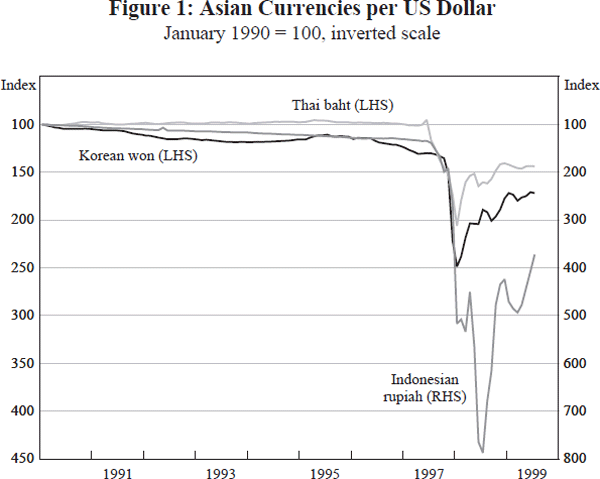
2. Country Experience
2.1 The crisis countries
If theory gives limited insights into the links between exchange rates and capital flows, we can look at the empirical experience to see what can be distilled from it. To focus the search, we might ask three questions.
- What part did exchange rates play in the pre-crisis period – e.g. in encouraging excessive inflows?
- Did overvalued exchange rates act as the trigger to set off the crisis in already-vulnerable economies?
- Once the crisis unfolded, what part did exchange rates play?
2.1.1 The pre-crisis period
This period was characterised by two stylised facts: domestic interest rates were significantly higher than foreign rates; and there were semi-fixed exchange rates vis-à-vis the US dollar. It might be expected that this would encourage capital inflow. There was a sharp rise in inflow in the first half of the 1990s (Table 1). Capital inflows had been significant but not huge until the early 1990s, but then rose to 10.5, 4.8 and 4.9 per cent of GDP in Thailand, Indonesia and Korea in 1996.
| 1977–82 | 1983–89 | 1990–94 | 1995 | 1996 | 1997 | |
|---|---|---|---|---|---|---|
| Thailand | 1.8 | 2.5 | 10.6 | 21.9 | 19.5 | −15.8 |
| Indonesia | 1.5 | 3.4 | 5.2 | 10.3 | 10.9 | −0.6 |
| Korea | 3.9 | −6.1 | 6.1 | 17.3 | 23.9 | −9.2 |
|
Note: Capital account flows adjusted for changes in official foreign exchange reserves. Sources: Balance of Payments Statistics, IMF, various issues. |
||||||
Were these increased flows a result of the semi-fixed exchange rates, combined with high interest rates? These were certainly high-profit, high-return countries[8] which should have attracted big capital flows. The problem with this explanation is one of timing. The increased capital inflows were not associated with any change in either the exchange rate or interest rate fundamentals. The quasi-fixed exchange rate had been in place for a decade or more, and the higher interest rates even longer (Figure 2).
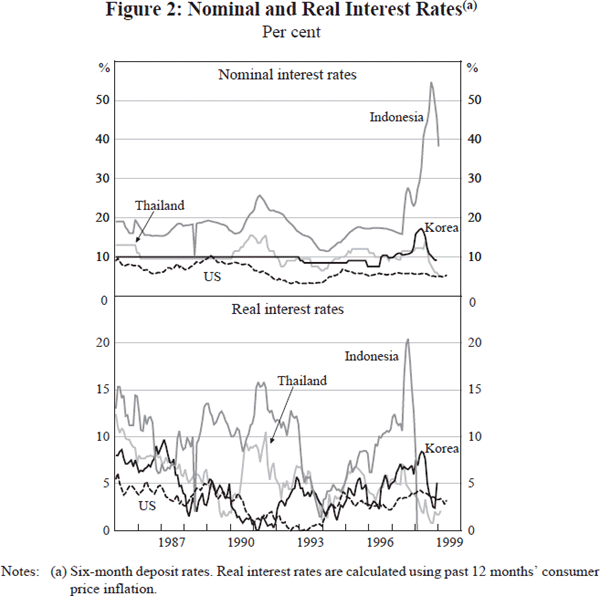
An alternative explanation was that the flows were largely driven by developments on the supply side (see de Brouwer (this volume)): the growth of mutual funds; vigorous competition among financial institutions to encourage and facilitate flows; and interest rate/exchange rate changes in the capital-supplying countries (particularly the ‘yen carry’). This change on the supply side is reflected in a significant reduction in risk margins required by investors – risk premia on emerging market bonds, in general, were driven down from nearly 8 per cent in 1991 to 4½ per cent in the first half of 1997 (based on J.P. Morgan Emerging Market Bond Index). To a large degree, the crisis countries were on the receiving end of a large increase in overall international capital flows to emerging markets. Furman and Stiglitz (1998, Figure 5) show net long-term private capital flows to all developing countries (as a per cent of GDP) rising threefold in the first half of the 1990s, about the same increase as for the Asian countries.
But there are two blades to Marshall's scissors: even if the foreign supply-side forces were the dominant factor in encouraging the big increase in capital inflow, we might expect to see an interaction between the interest rates and the exchange rates that would have further encouraged the inflow. In the classic self-reinforcing process, the increased capital inflow cannot be absorbed (through a bigger current account deficit) without a rise in the real exchange rate, so instead the capital inflow boosts foreign exchange reserves and thence domestic liquidity. Either this expands credit and drives up prices (appreciating the real exchange rate) or the authorities attempt to maintain monetary discipline by sterilising the capital inflow. This pushes up interest rates even further, which attracts more capital.
These mechanisms did not seem to be operating strongly in the crisis countries. While it is true that the current account deficit did not rise as quickly as the capital inflow (and hence foreign exchange reserves rose significantly), this did not seem to lead to an abnormal expansion in domestic liquidity and credit, driving up prices. Whereas credit grew much faster than nominal GDP in the early 1990s in Thailand and Indonesia, credit growth slowed in 1995 and 1996 (see Goldstein and Hawkins (1998, Table 7)). Even more notably, real exchange rates did not rise much (see Figure 3).[9],[10]
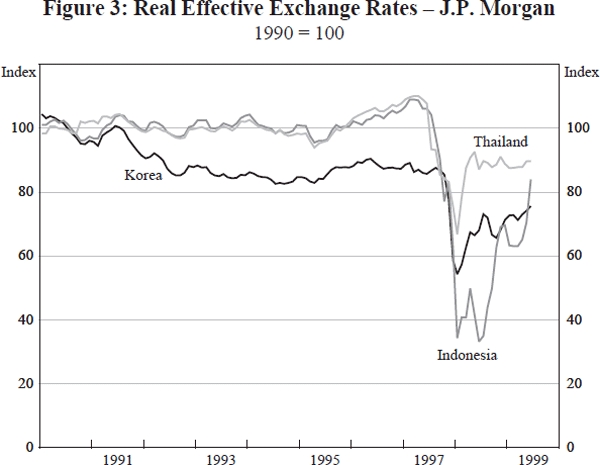
This does not imply that semi-fixed rates had no effect on capital flows. Certainly, many borrowers turned to foreign-exchange-denominated loans because they were close to 10 per cent per annum cheaper than domestic borrowing – comparing nominal lending rates and making no allowance for possible exchange rate changes. Given the conditions at the time, this was rational enough. There were, if anything, reasons to think that the exchange rate might appreciate rather than depreciate, reducing the domestic-currency value of the borrower's obligation. After all, the authorities were working hard to hold the exchange rate down and reserves were rising – so if policy changed, the initial effect was likely to be an appreciation. For those borrowers who read their economic texts, there was also the Balassa-Samuelson effect, which suggested that these currencies would appreciate in a trend sense over time.[11]
But this just highlights the quandary that the authorities were in, in the face of the intrinsically higher interest rates (in turn a result of the high productivity growth as these countries' productive structure shifted towards the technological frontier). Could the authorities, by some careful choice of exchange rate regime or manipulation of the rate itself, create an expectation of gradual depreciation (to offset the higher interest rates) – along the lines of the portfolio balance model – without triggering a sharper change in exchange rate expectations? We will return to this question in the conclusion.
2.1.2 The trigger
One classic catalyst for crises of this type, elsewhere, has been an overvalued exchange rate. In Mexico in 1994, the real exchange rate was some 30 per cent higher than it had been when the exchange rate regime was put in place in 1988. More generally in Latin America, fixed exchange rates have been used as a strategy for anchoring expectations while inflation was brought under control. Even if this was a successful method of reducing inflation, it left a legacy of a substantially overvalued exchange rate. It should be emphasised that this was not the case in the Asian crisis countries. Furman and Stiglitz (1998) show various measures of competitiveness, and the worst case of overvaluation is Thailand which, on one measure, is overvalued by a modest 11 per cent (see Table 2). The standard J.P.Morgan index also suggests that overvaluations were mild[12] – in fact, rather less than would be expected, given the volume of capital inflow. The post-crisis near-reversion of real exchange rates in Korea and Thailand would also suggest that overvaluation was not a critical factor.
| Country | Methodology | |||
|---|---|---|---|---|
| PPP-1(a) (Jan–June 1997) |
PPP-2(b) (May 1997) |
Per capita GDP, adjusted(c) (1996) |
Monetary model(d) (May 1997) |
|
| Indonesia | 6 | −5 | −16 | 0 |
| Korea | −5 | 9 | 1 | −12 |
| Malaysia | 12 | 8 | −41 | 2 |
| Philippines | 37 | 19 | −16 | −24 |
| Thailand | 11 | 7 | −18 | 2 |
| Taiwan | −2 | −3 | — | 8 |
| Singapore | 20 | −6 | −18 | 35 |
| Argentina | 65 | — | 34 | — |
| Brazil | 33 | — | 33 | — |
| Mexico | 3 | — | −18 | — |
| South Africa | −4 | — | −17 | — |
| United States | 4 | — | −30 | — |
|
Notes: (a) Percentage change between real exchange rate average over 1989–91
and average over January to June 1997. Source: Reproduced from Furman and Stiglitz (1998, Table 2) |
||||
But the issue with fixed rates – even one which is not significantly overvalued – is always the problem of exit. Once the semi-fixed rates were abandoned, this may well have been the trigger for markets to focus on more fundamental vulnerabilities.[13] Once this anchor of policy collapsed, all other elements of policy were under question and the vulnerabilities which, until then, markets had simply noted – with the hope that they would be addressed and fixed in due course – suddenly became pressing, and confidence-sapping.
2.1.3 The unfolding crisis
Once the trigger of the crisis occurred, considerations of the pre-crisis fundamentals became irrelevant – the exchange rate was driven by the market's expectation of how the crisis would evolve. To the extent that theory can offer guidance, it is the various generations of crisis theories – Krugman (1979), Obstfeld (1996) (surveyed by Dooley and Walsh (this volume)) – that are relevant. Market participants now focused on three separate concerns:
- That inflation would validate a much lower nominal exchange rate. Even if the initial real exchange rate was re-established in due course, this could be done either by higher inflation or by a reversion of the nominal exchange rate, and the market was, in effect, punting on the former. In these circumstances, there is no clear anchor for the nominal exchange rate.
- That the generally good macro policy record of these countries would not be maintained.
- Most serious of all for lenders, that the creditworthiness of their debtors would be fatally compromised either by the fall in the exchange rate or the on-coming recession in economic activity – credit risk replaced exchange rate risk.
As the crisis broke, the capital reversal was analogous to a bank run, where investors have little reason to remain, and every incentive to go. Investors made an on/off ‘binary’ decision to cut their losses and get out ahead of the others. Special mention is often made that domestic players were first to flee these currencies.[14] But the capital account data show one dominant group of foreign investors which seems to have taken flight at the earliest opportunity – foreign banks who had lent to domestic banks. Understandably so: they had no reason to stay, and the government guarantees provided the liquidity to facilitate their capital withdrawal. Bank-to-bank capital fled, before the possibility of controls or default could become a reality (Figure 4).[15] Higher domestic-currency interest rates provided no encouragement for the foreign-currency-denominated flows to stay. In fact, the exchange rate fall was a self-reinforcing unstable process: by reducing prospective output and increasing the likelihood of bankruptcies among domestic companies, it increased credit risk and encouraged even greater outflow. In Indonesia, various non-economic events triggered further sharp falls in the exchange rate. With the notable exception of Soros in Indonesia late in 1997, there were few Friedmanite stabilising speculators with their eyes on the fundamentals.
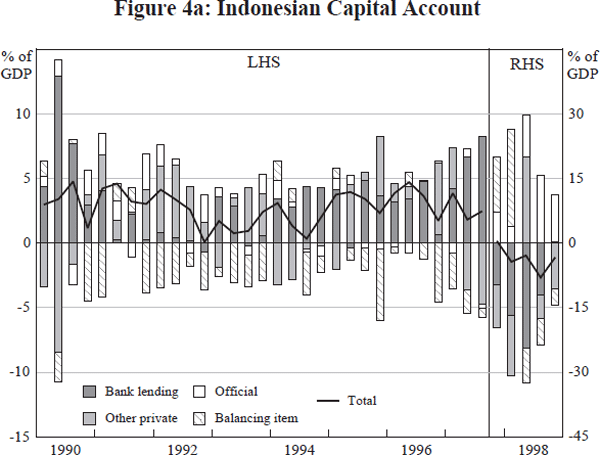
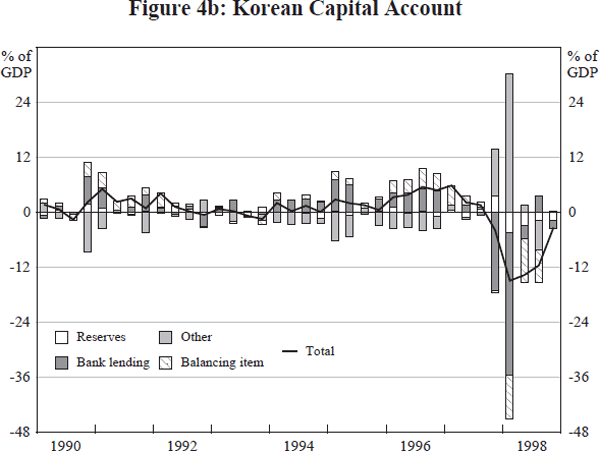
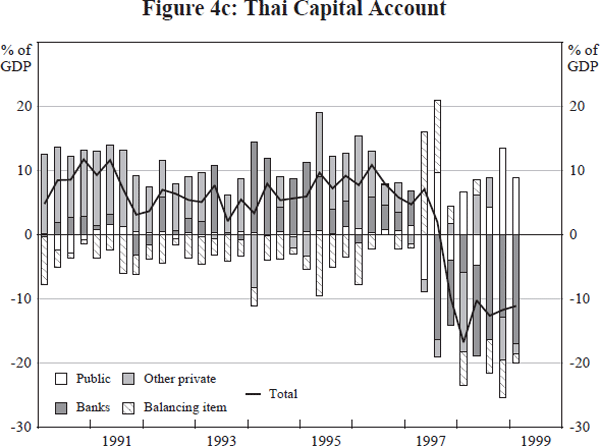
What role did the exchange rate have in the face of these huge and insistent outflows? With all the emphasis on what the exchange rate might do in the very short term (and with few looking at the medium term), the mechanism of the conventional model (a depreciation creates the expectation of a later appreciation) was not in operation. These outflows were brought into balance with available foreign exchange, not by the arrival of stabilising speculators, but by a combination of factors:
- The fall in the exchange rate limited the amount which residents could afford to send overseas.
- Tighter liquidity (in Thailand and Korea)[16] also restrained residents' ability to join the exodus.
- Most importantly, the fall in output and lower exchange rate produced a current account surplus. In all cases, this occurred with dramatic speed: each country moved from large deficit to surplus in a quarter or two following the crisis. The average turnaround in the current accounts of the three countries in the year following the crisis was about 12 per cent of GDP.
We have argued here that the unanchored nature of expectations is a key factor in understanding exchange rate behaviour. We have some survey data on this, shown in Figure 5. We cannot take this as representative of all market players, but as the exchange rate moved, respondents expected it to remain more-or-less where it now was, neither extrapolating the recent movement nor expecting the rate to revert any time soon. Maybe the sample is over-representative of economists who have accepted the Meese-Rogoff (1983) verdict that today's rate is the best estimate of tomorrow's.
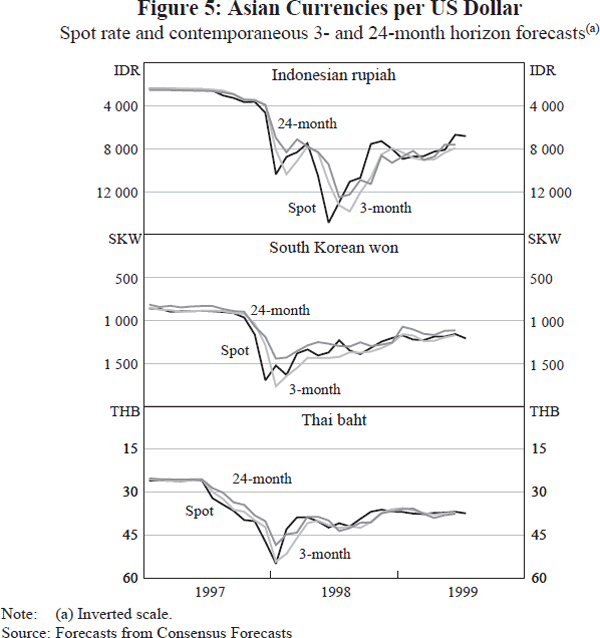
2.2 Singapore
If the crises in these three countries have an air of inevitability about them, once the massive capital flows began, Singapore provides a counter-example in the successful absorption of huge foreign inflows in the twenty years after the mid 1960s. Despite the size of these transfers of foreign inflows, and the extended period over which they occurred, the process appears to have been fairly smooth; certainly devoid of any reversals of the kind we have seen in the 1997/98 Asian crisis.
Figure 6 shows Singapore's current account balance and the J.P. Morgan measure of the real effective exchange rate since 1970. Over this period, Singapore moved from a current account deficit of 30 per cent of GDP to a surplus of over 10 per cent.
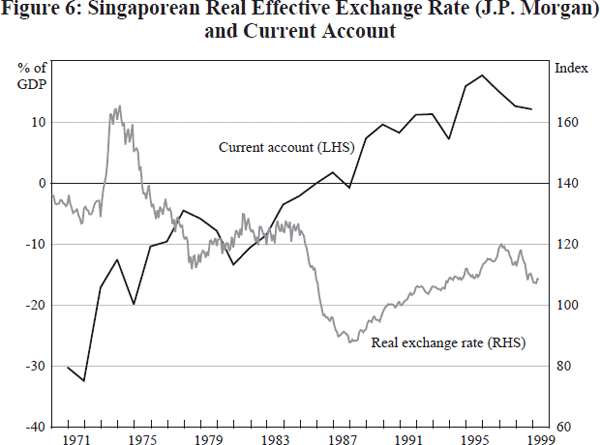
It was not, however, necessary for the real exchange rate to move by much to accommodate this significant sustained shift in the external accounts.[17] This is presumably a consequence of the large component of direct investment (where the decision to invest usually results in both capital flow and goods flow) and of Singapore's high degree of openness, so that small changes in the exchange rate produce large changes in exports and imports. But this does not invalidate Singapore as a relevant example – many developing countries are also very open (though usually less so than Singapore).
It is also noteworthy how little volatility was displayed by the Singaporean exchange rate over this period. With the exception of the couple of years surrounding the first OPEC oil crisis, and a short period in the mid 1980s, the real exchange rate changed only very gradually over time (Figure 6). The bilateral Singapore dollar/US dollar exchange rate over the same 30 years displays a similar lack of volatility. On this basis, the Singapore dollar displays year-to-year volatility that is less than one-half of the volatility of the exchange rates of the G3 economies against each other (Figure 7).
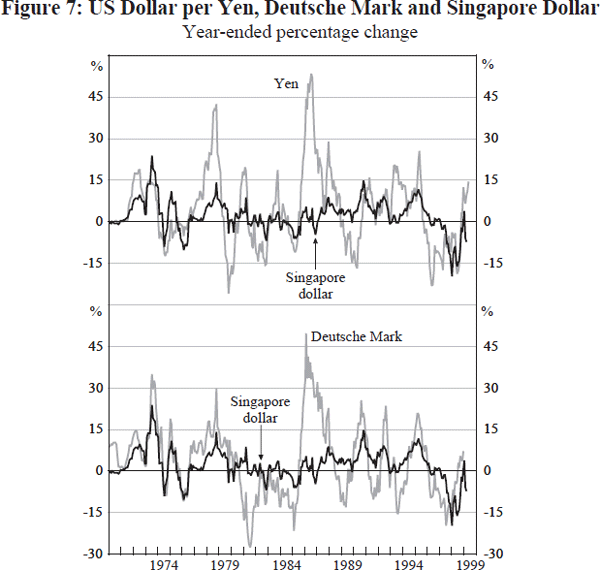
This lack of volatility appears, to a considerable extent, to result from deliberate government policy. The exchange rate is flexible, but it is an important domestic objective to keep its trade-weighted value relatively stable, because Singapore is so open to trade. This relative stability is achieved using monetary policy, intervention in the foreign exchange market, and restrictions on foreigners' capacity to borrow Singapore dollars, which seem to have reduced the extent of speculation in the currency.
2.3 Latin America
In common with other regions, Latin America has seen a significant shift over time to more flexible exchange rate arrangements. Over the period 1974–81, over three-quarters of Latin American currencies were fixed to other currencies, and almost none were floating; by 1989–94, the proportion of fixed rates had fallen to about one-third, while those with either a free or ‘dirty’ float had risen to over 40 per cent (Freiden, Ghezzi and Stein 1998).
The experience of Latin American countries with flexible exchange rates may be of more relevance to other developing countries with similar financial and economic structures than the experience of more developed economies like Singapore or, for that matter, the commodity-exporting, floating-rate industrial countries – Australia, Canada and New Zealand.
Exchange rate flexibility has not, however, delivered the benefits to Latin American countries that might have been expected. Countries with more flexible exchange rate arrangements have performed worse than those with less flexible arrangements across a range of dimensions (Hausmann et al. 1999).
One of the main expected benefits of exchange rate flexibility is in cushioning the domestic economy from the effects of external shocks, including volatility in capital flows. In the aftermath of the Asian crisis, however, those Latin countries with more flexible exchange rate arrangements found it possible to use this flexibility only very sparingly. Rather than allowing their exchange rates to cushion the shock, they judged it appropriate to raise interest rates aggressively to defend their exchange rates.[18] Domestic interest rates were raised by less in those countries with less exchange rate flexibility.
It might also be expected that countries with more flexible exchange rates would have more domestic monetary independence than those with fixed rates – indeed, this proposition seems almost axiomatic. Again, however, the Latin American experience has not supported it. Domestic interest rates in Latin countries with more flexible exchange rate arrangements have moved more – although not statistically significantly more – in response to changes in foreign (US) interest rates than in those Latin countries with less exchange rate flexibility.[19] The uncertainty associated with exchange rate flexibility in these countries appears to exacerbate swings in the risk premium demanded by investors to hold domestic-currency-denominated assets, which in turn reduces their capacity for independent monetary actions.
It also appears that Latin countries with more flexible exchange rates have experienced higher real interest rates, on average, and less financial deepening, than those with less exchange rate flexibility. The Latin experience with exchange rate flexibility has thus been very much less positive than those of small open industrial economies like Singapore, or Australia, Canada and New Zealand.
3. Conclusion
The fact that the greater exchange rate instability may be associated with the increasing openness of economies might suggest that the old discussion about the ‘impossible triumvirate’ (fixed exchange rate, independent monetary policy and open capital markets) may be relevant. As these countries became more integrated (and thus open to capital flows) their fixed exchange rate regimes became inappropriate. The belief was that the ‘trilemma’ disappears if flexibility is allowed in the exchange rate. The current problem, however, is that even allowing the exchange rate to move, the overshooting may be substantially greater than anything envisaged in the models. ‘What is less obvious is that floating rates, independent monetary policy, and freedom of capital movements may also be incompatible, at least for countries with small and poorly developed domestic capital markets’ (Cooper 1999, p. 19).[20]
Would a floating exchange rate have saved the Asian countries from crisis? We have noted how this works in the textbook world – in the face of capital inflows, the exchange rate rises until it induces the expectation of a depreciation, and this discourages excessive inflows. But in the real world, expectations are often extrapolative. As the exchange rate rises, it is expected to rise further. Presumably, floating well in advance of the crisis would have initially increased the current account deficit as the nominal and real exchange rate appreciated. We cannot say that this would have implied, for example, a 13 per cent of GDP current account deficit for Thailand (i.e. equal to the capital inflow which occurred in 1995), but the current account deficit would have been larger, earlier, than actually occurred. This, in turn, might have precipitated the crisis earlier and, with hindsight, we might judge that to be a good thing. But it is hardly a recommendation for orderly policy-making.
Would a floating rate have solved the problem of unhedged foreign-currency borrowing? If a floating rate had prompted borrowers to worry about depreciation, this would have discouraged them from foreign-currency borrowing. As well, to the extent that the hedge counterparty protected its own exposure, hedging would have led to an offsetting capital outflow. So, for both reasons, the net capital inflow would have been smaller, which would have been a good thing. We have, however, argued that – even with a float – many borrowers would have taken a punt on depreciation, and remained unhedged. Hedging costs are roughly equal to the domestic/foreign interest differential, which was very high, and a depreciation of the size experienced was far outside any historical experience. Regardless of exchange rate regime, and no matter how sophisticated the financial engineering, big capital flows imply many players (either domestic or foreign) are exposed to exchange rate risk. This risk can be shifted to players more capable of withstanding the shocks, but it is much more difficult to remove the incentive they have to reverse their position when a crisis is judged to be imminent.
More exchange rate flexibility seems to be called for in these countries, but it seems unlikely that a freely floating rate would have achieved and maintained the path envisaged in the textbooks, where an expectation of gradual depreciation balances the intrinsically higher interest rates which these countries had (and will have again). The central issue is the unanchored nature of exchange rate expectations. As the rate moves, market participants do not look to the fundamentals to assess where the rate is in relation to these, because they know from past experience that these are a poor guide to movements over the time period relevant to them.[21] This explains why there are so few Friedmanite speculators (and very few in economies where the exchange rate fundamentals are not well-defined). So it is a chicken-and-egg problem – the exchange rate can depart substantially from its fundamentals because there are few stabilising speculators, and there are few because the rate departs from its fundamentals in ways that will make risk-aware speculators nervous.
So the dilemma for policy in these emerging economies is that a commitment to a fixed rate will anchor expectations effectively, provided the shock is not too great. If it is great enough to overwhelm the fixed rate, then the rate is without anchor, and will almost certainly overshoot, probably greatly. This unleashes the sort of self-reinforcing destabilising forces seen in Asia in 1997. A pure, free float provides no firm anchor for exchange rate expectations, at least until a reasonably long history is established.
The debate is clearly unresolved. But it would seem premature to argue that a pure, freely floating exchange rate would be appropriate for emerging market economies with small, poorly developed domestic capital markets, and fundamentals that are not well understood by international capital markets. What exchange rate regime these countries should choose seems much less clear-cut. Singapore provides one possible model, combining flexibility in the exchange rate, with restrictions on borrowing the domestic currency, and an active commitment to use monetary policy and foreign-exchange intervention to help limit movements in its trade-weighted value.
Footnotes
Special thanks to Luke Gower, Jonathan Kearns and Amanda Thornton for their help in preparing this paper. [*]
30 January 1999. [1]
Eichengreen (1994). [2]
See Frankel (1999). [3]
‘A freely flexible exchange rate would tend to remain constant so long as underlying economic conditions (including government policies) remain constant; random deviations from the equilibrium level would be limited by the activities of speculators’ (Harry Johnson 1973, p. 208), quoted by Cooper (1999, p. 8). [4]
The classic reference, Meese and Rogoff (1983), showed that existing exchange rate models based on economic fundamentals could not reliably out-predict the naïve alternative of a ‘no-change’ forecast for year-to-year changes in major industrial-country exchange rates. Some more recent models can out-predict a ‘no-change’ forecast (for example, MacDonald and Taylor 1993), but the basic empirical fact remains largely intact. No-one has yet been able to uncover macroeconomic fundamentals that explain more than a modest fraction of year-to-year changes in industrial-country floating exchange rates. Frankel and Rose (1995, p. 1707) summarise the dismal state of exchange rate empirical research: ‘… the case for macroeconomic determinants of exchange rates is in a sorry state. With the exception of some significance in bits of statistical innovation and announcements at very short horizons, and some hazy predictive power at long horizons, there is little support for standard macroeconomic models’. [5]
The combination of tight monetary and loose fiscal policy in the US was consistent with some appreciation of the US dollar in the early 1980s. Nevertheless, the magnitude of the observed appreciation still seems hard to justify on the basis of fundamentals alone. [6]
Over the year to June 1998, Indonesia's real exchange rate fell by 69 per cent – a fall with no known precedent. While Latin America records similar nominal depreciations, these were in high-inflation countries, which were often simply restoring their competitiveness. [7]
Radelet and Sachs (1998), quoting OECD data, show returns falling between the 1980s and 1990s, but still well above worldwide returns. [8]
For a couple of years before the crisis, there was some rise in real effective exchange rates in Thailand and Indonesia, but this was largely a result of the appreciation of the US dollar against the yen. [9]
Some equilibrating price adjustment occurred in asset prices: property prices rose (notably in Bangkok), which would have reduced the return on these assets. It is interesting to note that equity prices did not rise in the period of maximum inflow – they had peaked earlier. [10]
Most foreign-currency borrowers would have been aware of exchange rate risk. For Indonesia and Thailand, the most common denomination of loans was yen (see Goldstein and Hawkins (1998, Table 11)), and borrowers in countries fixed to the US dollar would have experienced the roller-coaster ride of the yen/US dollar rate in the first half of the 1990s. [11]
This is not undisputed (see Warr (1999)). [12]
Among which were the (probably cyclical) slowing in Thai exports in 1996, and the decline in the terms of trade for electronic-goods exporters. [13]
This argument is often used to support the claim that capital flows did not make these economies more vulnerable, and that outflows were just as likely to be initiated by domestic players who had no foreign borrowings. This may be so (although data seem scarce to justify a firm view): certainly, many unhedged borrowers (who had participated in the inflows) sought to cover their exposure by buying foreign exchange. [14]
This capital had come into the crisis countries at a rate of around US$50 billion per year before the crisis, and nearly US$75 billion (far bigger than the rescue packages) left in the nine months after the crisis. [15]
In Indonesia, Bank Indonesia's support for ailing banks provided liquidity. [16]
We examined the relationship between annual averages of the real exchange rate and the current account balance, 1970–1998. The correlation is quite clear and significant, in a direction that supports the standard story of the relationship between capital flows and the real exchange rate, but the size of the exchange rate response is small. To put numbers on this, a 5 per cent of GDP fall in the current account balance (a big movement in the external accounts for most countries, especially if it is sustained) was associated with an average real appreciation of only about 3½ per cent. [17]
It is understandable that countries with very bad inflation histories could not allow their exchange rates to fall by much, for fear of reigniting runaway inflationary expectations. But even Chile, with a reasonable (and progressively improving) inflation performance over the past 20 years, and sound public finances, judged it appropriate to raise interest rates aggressively to limit the movement in its exchange rate. As a consequence, Chile was plunged into a severe recession, its first since 1982/83. [18]
Frankel (1999) reports a similar result. [19]
A similar sentiment is expressed by Krugman (1999, p. 111): ‘The common view among economists that floating rates are the best, if imperfect, solution to the international monetary trilemma was based on the experience of countries like Canada, Britain, and the United States. And sure enough, floating exchange rates do work pretty well for First World countries, because markets are prepared to give those countries the benefit of the doubt. But since 1994 one Third World country after another – Mexico, Thailand, Indonesia, Korea, and, most recently, Brazil – has discovered that it cannot expect the same treatment. Again and again, attempts to engage in moderate devaluations have led to a drastic collapse in confidence. And so now markets believe that devaluations in such countries are terrible things; and because markets believe this, they are’. [20]
This point is not new. Sir Isaac Newton, having lost £20,000 on the South Sea bubble, remarked: ‘I can calculate the motions of heavenly bodies, but not the madness of people’. [21]
References
Chinn, MD (1998), ‘Before the Fall: Were East Asian Currencies Overvalued?’, NBER Working Paper No. 6491.
Cooper, RN (1999), ‘Exchange Rate Choices’, Rethinking the International Monetary System, paper presented to Federal Reserve Bank of Boston Conference, June.
de Brouwer, Gordon (1999), ‘Capital Flows to East Asia: The Facts’, this volume.
Dooley, Michael P and Carl E Walsh (1999), ‘Academic Views of Capital Flows: An Expanding Universe’, this volume.
Dornbusch, R (1976), ‘Expectations and Exchange Rate Dynamics’, Journal of Political Economy, 84(6), pp. 1161–1176.
Eichengreen, B (1994), International Monetary Arrangements for the 21st Century, Integrating National Economies Series, Brookings, Washington, DC.
Frankel, JA (1989/90), ‘Chartists, Fundamentalists and Trading in the Foreign Exchange Market’, in NBER Reporter, Winter, pp. 9–12.
Frankel, JA (1999), ‘No Single Currency Regime is Right for All Countries or at All Times’, Frank Graham Lecture at Princeton University, 20 April.
Frankel, JA and KA Froot (1990), ‘Chartists, Fundamentalists and the Demand for Dollars’, in AS Courakis and MP Taylor (eds), Private Behavior and Government Policy in Interdependent Economies, Clarendon Press, New York, pp. 73–126.
Frankel, JA and AK Rose (1995), ‘Empirical Research on Nominal Exchange Rates’, in G Grossman and K Rogoff (eds), Handbook of International Economics, Vol. III, Elsevier Science, Amsterdam, pp. 1689–1729.
Freiden, J, P Ghezzi, and E Stein (1998), ‘The Political Economy of Exchange Rate Policy in Latin America’, Inter-American Development Bank, Washington, DC.
Froot, KA and K Rogoff (1995), ‘Perspectives on PPP and Long-Run Real Exchange Rates’, in G Grossman and K Rogoff (eds), Handbook of International Economics, Vol. III, Elsevier Science, Amsterdam, pp. 1647–1688.
Furman, J and JE Stiglitz (1998), ‘Economic Crises: Evidence and Insights from East Asia’, Brookings Papers on Economic Activity, 2, pp. 1–135.
Goldstein, M and J Hawkins (1998), ‘The Origin of the Asian Financial Turmoil’, Reserve Bank of Australia Research Discussion Paper No. 9805.
Hausmann, R, M Gavin, C Pages-Serra and E Stein (1999), ‘Financial Turmoil and the Choice of Exchange Rate Regime’, Inter-American Development Bank, Washington, DC.
Johnson, HG (1972), ‘The Case for Flexible Exchange Rates, 1969’, Further Essays in Monetary Economics, Harvard University Press, Cambridge, pp. 198–228.
Krugman, P (1979), ‘A Model of Balance-of-Payments Crises’, Journal of Money, Credit, and Banking, 11(3), pp. 311–325.
Krugman, P (1999), The Return of Depression Economics, W.W. Norton & Company Inc., New York.
MacDonald, R and MP Taylor (1993), ‘The Monetary Approach to the Exchange Rate: Rational Expectations, Long-Run Equilibrium and Forecasting’, IMF Staff Papers, 40(1), pp. 89–107.
Meese, RA and K Rogoff (1983), ‘Empirical Exchange Rate Models of the Seventies: Do They Fit Out of Sample?’, Journal of International Economics, 14(1/2), pp. 3–24.
Obstfeld, Maurice (1996), ‘Models of Currency Crises with Self-fulfilling Features’, European Economic Review, 40(3–5), pp. 1037–1047.
Radelet, S and JD Sachs (1998), ‘The East Asian Financial Crisis: Diagnosis, Remedies, Prospects’, Brookings Papers on Economic Activity, 1, pp. 1–90.
Warr, P (1999), ‘Capital Mobility and the Thai Crisis’, paper presented to Conference on International Capital Mobility and Domestic Economic Stability, hosted by the Reinventing Bretton Woods Committee, The World Bank and The Australian National University, Canberra, 14 July.
World Bank (1998), World Development Indicators, Washington, DC.